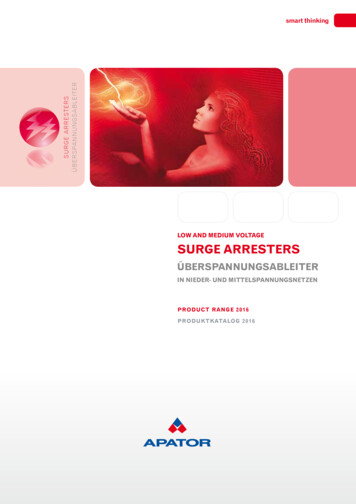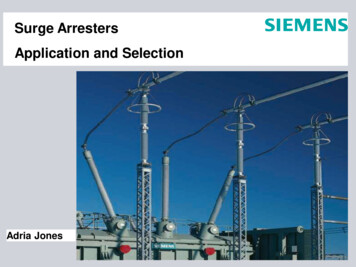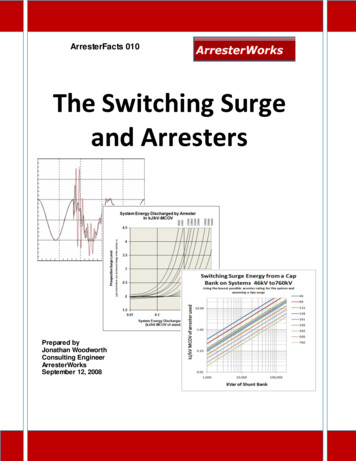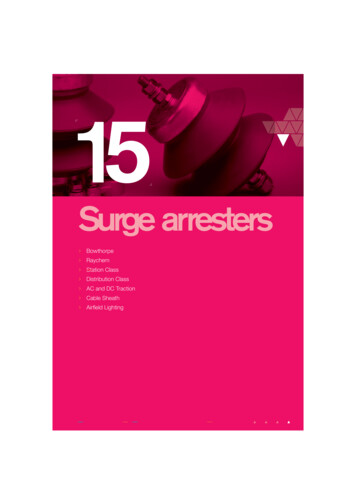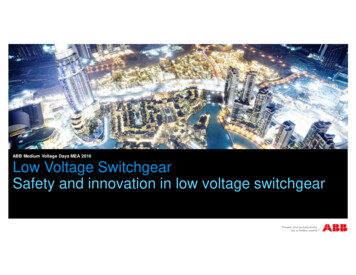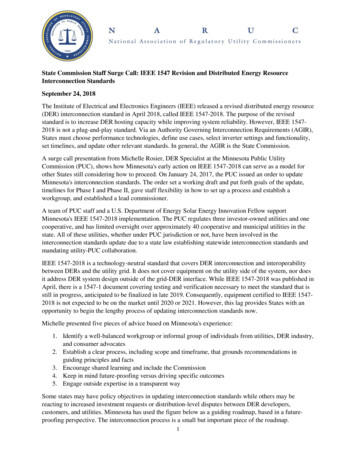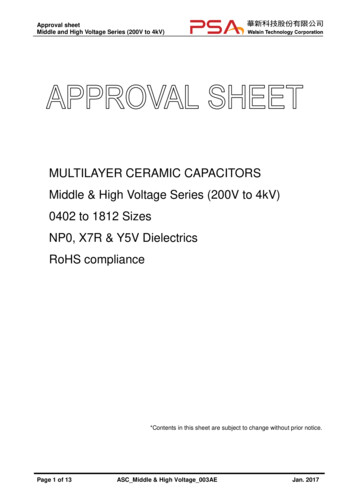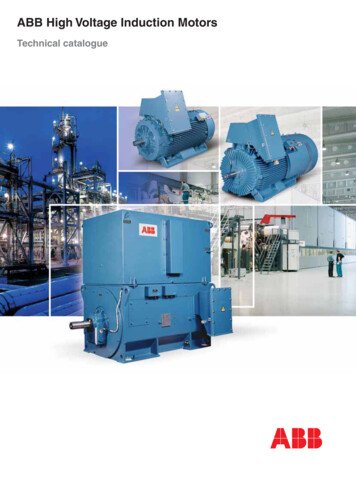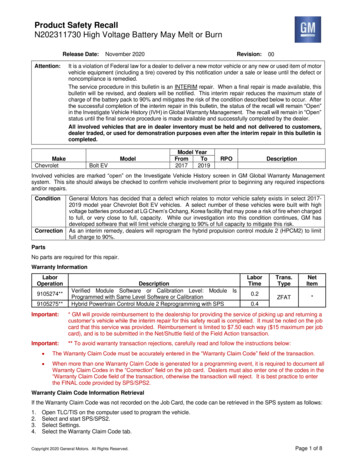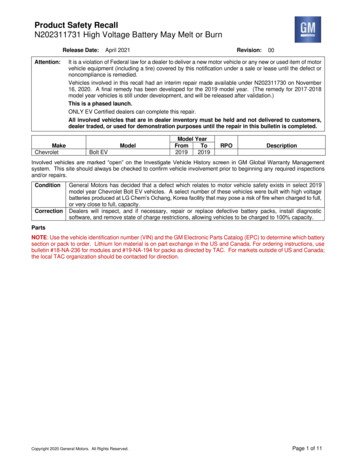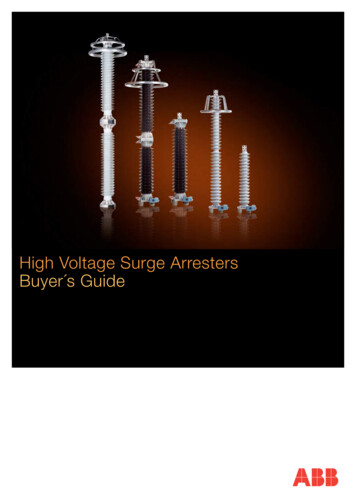
Transcription
High Voltage Surge ArrestersBuyer s GuideDocument ID 1HSM 9543 12-00en, High Voltage Surge Arresters, Byuer s Guide, Edition 14, May-2018Contact us
Table of contentsProduct informationIntroduction3Definitions4Simplified selection procedure7Design features - Porcelain-housed surge arresters, EXLIM15Design features - Polymer-housed surge arresters PEXLIM and TEXLIM17The PEXLINK concept22Quality control and testing28Technical informationPEXLIM — Zinc oxide surge arresters with silicone polymer-housed insulator:PEXLIM R-Y, 10 kA, IEC arrester class designation SL29PEXLIM Q-Y, 10 kA, IEC arrester class designation SM36PEXLIM P-Z, 20 kA, IEC arrester class designation SH43PEXLIM P-Y, 20 kA, IEC arrester class designation SH50TEXLIM — High strength zinc oxide surge arresters with silicone polymer-housed insulator:TEXLIM Q-C, 10 kA, IEC arrester class designation SM56TEXLIM P-C, 20 kA, IEC arrester class designation SH63TEXLIM T-C, 20 kA, IEC arrester class designation SH69EXLIM — Zinc oxide surge arresters with porcelain-housed insulator:EXLIM R, 10 kA, IEC arrester class designation SL75EXLIM Q-E, 10 kA, IEC arrester class designation SM81EXLIM Q-D, 10 kA, IEC arrester class designation SM88EXLIM P, 20 kA, IEC arrester class designation SH94EXLIM T, 20 kA, IEC arrester class designation T-I114EXCOUNT-II116EXCOUNT-III120OtherPurchase order119Installations with ABB surge arresters1212 Product information ABB Surge Arresters — Buyer s Guide
Safe, secure and economic supply ofelectricity — with ABB surge arrestersABB surge arresters are the primary protection against atmospheric and switchingovervoltages. They are generally connected in parallel with the equipment to be protectedto divert the surge current. The active elements (MO resistors) of ABB surge arresters aremanufactured using a highly non-linear ceramic resistor material, composed primarily ofzinc oxide mixed with other metal oxides and sintered together.Strong focus on quality at all stages, from raw materialthrough to finished product, ensures that ABB surge arresterssurvive the designed stresses with ease and with good margins. Different dimensions permit a large variety of standardarresters as well as client-specific solutions with regards protection levels, energy capability and mechanical performance.This Buyer’s Guide deals with high voltage surge arrestersfor standard AC applications. For other applications, such asseries capacitors protection, shunt capacitor protection or DCapplications, contact your ABB sales representative.Product rangeArresterTypeclassificationMax. systemvoltageRated voltage2)kV rms2)Energy requirement/MechanicalLightning intensitystrengthkV rms3)NmPEXLIM — Silicone polymer-housed arresterSuperior where low weight, reduced clearances, flexible mounting, non-fragility and additional personnel safety is required.Major component for PEXLINKTM concept for transmission line protection.10 kA, IEC station class designation SLPEXLIM R-Y24 - 17018 - 144Moderate1 60010 kA, IEC station class designation SMPEXLIM Q-Y52 - 42042 - 396High4 00020 kA, IEC station class designation SHPEXLIM P-Z52 - 42042 - 396Very high6 00020 kA, IEC station class designation SHPEXLIM P-Y300 - 550228 - 444Very high9 000TEXLIM — High strength silicone polymer-housed arresterSpecially suited to extreme seismic zones.10 kA, IEC station class designation SMTEXLIM Q-C123 - 42090 - 420High40 00020 kA, IEC station class designation SHTEXLIM P-C245 - 550180 - 444Very high40 00020 kA, IEC station class designation SHTEXLIM T-C245 - 800180 - 624Very high40 00010 kA, IEC station class designation SLEXLIM R52 - 17042 - 168Moderate7 50010 kA, IEC station class designation SMEXLIM Q-E52 - 24542 - 228High7 50010 kA, IEC station class designation SMEXLIM Q-D170 - 420132 - 420High20 00020 kA, IEC station class designation SHEXLIM P52 - 55042 - 444Very high20 00020 kA, IEC station class designation SHEXLIM T245 - 800180 - 624Very high20 000EXLIM — Porcelain-housed arrester1)2)3)Arrester classification according to IEC 60099-4.Arresters with lower or higher voltages may be available on request for special applications.Specified short-term service load (SSL).ABB Surge Arresters — Buyer s Guide Product information 3
DefinitionsNOTE! The standards referred to hereunder are the latesteditions of IEC 60099-4 and IEEE C62.11es. Other sources of TOV are load-rejection, energization ofunloaded lines, ferroresonance, etc. The TOV capability of thearresters is indicated with prior energy stress in the relevantcatalogues.Maximum system voltage (Us)The maximum voltage between phases during normal service.Residual voltage/Discharge voltageThe peak value of the voltage that appears between the terminals of an arrester during the passage of discharge currentthrough it. Residual voltage depends on both the magnitudeand the waveform of the discharge current. The voltage/current characteristics of the arresters are given in the relevantcatalogues.Nominal discharge current (IEC)The peak value of the lightning current impulse which is usedto classify the arrester.Lightning classifying current (ANSI/IEEE)The designated lightning current used to perform the classification tests.Rated voltage (Ur)An arrester fulfilling the IEC standard must withstand itsrated voltage (U r) for 10 s after being preheated to 60 Cand subjected to energy injection as defined in the standard.Thus, U r shall equal at least the 10-second TOV capability ofan arrester. Additionally, rated voltage is used as a referenceparameter.NOTE! TOV capability of ABB arresters exceeds the IECrequirements.Duty-cycle voltage rating (IEEE)The designated maximum permissible voltage between its terminals at which an arrester is designed to perform its duty cycle.Continuous operating voltageThe maximum permissible r.m.s. power frequency voltage thatmay be applied continuously between the arrester terminals.This voltage is defined in different ways (verified by differenttest procedures) in IEC and IEEE. IEC (Uc)IEC gives the manufacturer the freedom to decide Uc. Thevalue is verified in the operating duty test. IEEE (MCOV)IEEE lists the maximum continuous operating voltage(MCOV) for all arrester ratings used in a table. The value isused in all tests specified by IEEE.Temporary overvoltages (TOV)Temporary overvoltages, as differentiated from surge overvoltages, are oscillatory power frequency overvoltages ofrelatively long duration (from a few cycles to hours).The most common form of TOV occurs on the healthy phasesof a system during an earth-fault involving one or more phas-4 Product information ABB Surge Arresters — Buyer s GuideArrester class Distribution class arrester (IEC designations: DL, DM,DH)An arrester intended for use on distribution systems,typically of Us 52 kV, to protect components primarily from the effects of lightning. Station class arrester (IEC designations: SL, SM, SH)An arrester intended for use in stations to protect theequipment from transient overvoltages, typically butnot only intended for use on systems of Us 72,5 kV.Energy capabilityThe energy that a surge arrester can absorb, in one ormore impulses, without damage and without loss of thermalstability. The energy capability of a surge arrester is differentdepending on the type, duration and grouping of applied impulses as well as what occurs afterwards. Arrester standardshave historically not explicitly defined the energy capability ofan arrester, and the current editions have specifically focusedon attempting to resolve this deficiency in the following forms(IEC 60099-4 definitions): Repetitive charge transfer rating, QrsThe maximum specified charge transfer capability of anarrester, in the form of a single event or group of surgesthat may be transferred through an arrester without causingmechanical failure or unacceptable electrical degradation tothe MO resistors. This applies to both station and distribution class arresters. Thermal charge transfer rating, Q thThe maximum specified charge that may be transferredthrough an arrester or arrester section within 3 minutes ina thermal recovery test without causing a thermal runaway.This applies only to distribution class arresters.
Thermal energy rating, WthThe maximum specified energy, given in kJ/kV of Ur, thatmay be injected into an arrester or arrester section within 3minutes in a thermal recovery test without causing a thermal runaway. This applies only to station class arresters.Polymeric insulators of hydrophobicity transfer material(HTM), e.g. silicone, present advantages including a generallyimproved pollution withstand behaviour when compared tosimilar ceramic insulators of equal creepage distance. Froma pollution withstand or flashover point of view, a reducedcreepage distance may be used on PEXLIM and TEXLIM arresters with such HTM insulators.Short-circuit capabilityThe ability of an arrester, in the event of an overload due toany reason, to conduct the resulting system short-circuitcurrent without violent shattering which may damage nearbyequipment or injure personnel. After such an operation, thearrester must be replaced. The system short-circuit currentmay be high or low depending on the system impedance andearthing conditions and hence short-circuit capability is verified at different current levels.The creepage distance is the length measured along thehousing’s external profile and serves as a measure of thearrester performance in polluted environments with respectto the risk of external flashover. Since the mean diameterfor all the standard arresters is less than 300 mm, the specific creepage distance is the same as the nominal creepagedistance.External insulation withstand strengthThe maximum value of the applied voltage of a specified waveshape which does not cause the flashover of an arrester.Unlike other equipment, arresters are designed to dischargeinternally and the voltage across the housing can never exceed the protective levels. Thus, the external insulation of arrester housings is self-protected and need not fulfill a certainstandardized insulation class provided its insulation withstandstrength is higher than the protective levels by a designatedsafety factor and appropriately corrected for installation altitude.SLLSpecified long-term load allowed to be continuously appliedduring service without causing any mechanical damage to thearrester.SSLSpecified short-term load allowed to be applied during servicefor short periods and for relatively rare events without causingany mechanical damage to the arrester.MBLMean breaking load is the average breaking load for porcelain-housed arresters.NOTE! The insulation withstand of ABB surge arresters hasbeen thoroughly considered in the design, and spacings between metal flanges as well as spacings between flanges andgrading rings are sufficiently large to withstand overvoltagesappearing during current discharges. All ABB arresters aresuitable for installations up to at least 1000 m above sea level,often with a large margin.Pollution performanceIEC 60815 defines five levels of pollution (from very light tovery heavy), with the traditional correspondingly requiredcreepage for porcelain housings as indicated in the tablebelow.Site pollutionPollution level Specific creepage inmm/kV (Us)severity classUnified specificcreepage distancemm/kV (Us/ 3)aVery light12.722.0bLight (L)1627.8cMedium (M)2034.7dHeavy (H)2543.3eVery heavy (V)3153.7ABB Surge Arresters — Buyer s Guide Product information 5
DefinitionsLine Surge Arresters (LSA)BackflashoverOccurs when lightning strikes the tower structure or overheadshield wire. The lightning discharge current, flowing throughthe tower and tower footing impedance, produces potentialdifferences across the line insulation. If the line insulationstrength is exceeded, flashover occurs i.e. a backflashover.Backflashover is most prevalent when tower footing impedance is high.Compact insulation linesTransmission lines with reduced clearances between phasesand between phase and earth and with lower insulation levelwithstand than for normal lines for the same system voltage.Coupling factorThe ratio of included surge voltage on a parallel conductorto that on a struck conductor. This factor is determined fromthe geometric relationships between phase and ground (orprotected phase conductors). A value often used for estimation purposes is 0.25.Keraunic levelNumber of annual thunderstorm days for a given region.LSALine Surge Arresters are intended for installation in overheadlines in parallel to the line insulators in order to prevent flashovers, which may be either: non-gapped line arrester (NGLA)arrester without internal or external series gap externally gapped line arrester (EGLA)arrester with series gap used to protect an insulator assembly from lightning-caused fast-front overvoltages onlyNOTE! PEXLINK is a NGLAShieldingProtection of phase conductors from direct lightning strokes;generally, by means of additional conductor(s) running on thetop of the towers and grounded through the tower structures.Shielding angleThe included angle, usually between 20 to 30 degrees, between shield wire and phase conductor.Shielding failureOccurs when lightning strikes a phase conductor of a line protected by overhead shield wires.Tower footing impedanceThe impedance seen by a lightning surge flowing from thetower base to true ground. The risk for backflashover increases with increasing footing impedance.Travelling wavesOccur when lightning strikes a transmission line span and ahigh current surge is injected on to the struck conductor.The impulse voltage and current waves divide and propagatein both directions from the stroke terminal at a velocity ofapproximately 300 meters per microsecond with magnitudesdetermined by the stroke current and line surge impedance.6 Product information ABB Surge Arresters — Buyer s Guide
Simplified selection procedureThe selection
ABB surge arresters are the primary protection against atmospheric and switching overvoltages. They are generally connected in parallel with the equipment to be protected to divert the surge current. The active elements (MO resistors) of ABB surge arresters are manufactured using a highly non-linear ceramic resistor material, composed primarily of zinc oxide mixed with other metal oxides and .
